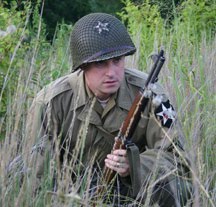 |
| Each Marauder styled his Daisy Mae HBT Cap in a unique shape to fit their own personal tastes. |
Merrill’s Marauders, named after Frank Merrill, was officially named the 5307th Composite Unit (Provisional). It was a United States Army long range penetration special operations jungle warfare unit, which fought in the China Burma India Theater of World War II, or CBI. The unit became famous for its deep-penetration missions behind Japanese lines, often engaging Japanese forces superior in number. In slightly more than five months of combat, the Marauders advanced 1,200 kilometres (750 mi) through some of the harshest jungle terrain in the world, fought in 5 major engagements (Walawbum, Shaduzup, Inkangahtawng, Nhpum Ga, and Myitkyina) and engaged in combat with the Japanese Army on thirty-two separate occasions, including two conventional defensive battles with enemy forces for which the force had not been intended nor equipped. Battling Japanese soldiers, hunger, fevers, and disease, they traversed more jungle terrain on their long-range missions than any other U.S. Army formation during World War II. The men of the Merrill's Marauders enjoyed the rare distinction of having each soldier awarded the Bronze Star. In June 1944, the 5307th Composite Unit (provisional) was awarded the Distinguished Unit Citation. On August 10, 1944 the Marauders were consolidated into the 475th Infantry. On June 21, 1954 the 475th Infantry was re-designated as the 75th Infantry; thus Merrill's Marauders is the parent of the 75th Infantry Regiment, from which descended the 75th Ranger Regiment.
This was a pretty exciting uniform to assemble for October. I am leaving on a business trip to China on October 14, so I thought it was a timely impression to pull together and one that I could assemble quickly. The only October reference I could find for the unit was that the men were sent to India arriving in Bombay on October 31, 1943 for training. The unique components of this uniform are the HBT Daisy Mae Hat, the HBT uniform with leggings worn under the trousers, the Jungle First Aid Kit and a Machete. Upon seeing the photos of myself there is quite a bit of swagger associated with this unit and its uniform. I think that the manner in which each soldier in the 5307th customized his uniform, especially the way they wore their HBT caps, gave them a very distinctive look.
 |
| The Jungle First Aid Pouch hangs from the right side of the cartridge belt. |
 |
| Attached to the Haversack is an M1 Bayonet in an M7 Scabbard. |
 |
| On my left hip is the canvas Machete Sheath and a 1942 Machete. |
 |
| This Machete is ready for business. Hanging from my chest pocket is a MK-II Fragmentation Grenade. |
 |
| Marauders frequently affixed their steel M1 Helmet to the back of their Haversacks. |
 |
| A smiling Marauder in the jungles of Burma. |
 |
| The real Merrill's Marauders resting outside of Nhpum Ga in Northern Burma, circa late March or early April 1944. |


























































